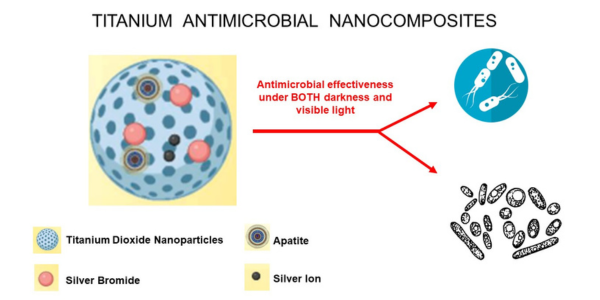(LOS ANGELES) - Scientists from the Terasaki Institute for Biomedical Innovation (TIBI) have chemically modified titanium dioxide nanoparticles to render them with antimicrobial powers when exposed to both darkness and visible light. These composite nanoparticles, studded with selected chemicals, demonstrated antibacterial and antifungal effectiveness, while serving as models to elucidate the pathways by which these effects are achieved. This opens enticing possibilities for green technology applications, such as wastewater treatment, air purification, or preservation of food.
Titanium dioxide is a readily available, low-toxic, and low-cost mineral that is used to make porcelain enamels bright. Since it can absorb ultraviolet light, it is also used in cosmetics, especially skin care and sunscreen products. This absorptive ability classifies titanium dioxide as a photocatalyst – a material that changes the rate of a chemical reaction upon exposure to light.
Scientists have experimented with titanium dioxide and other photocatalysts and have studied their antimicrobial properties, but much work needs to be done to understand the mechanisms involved in these effects and to improve performance.
Efforts to leverage titanium dioxide’s antimicrobial capabilities for practical and commercial purposes are further hindered by its effectiveness only under ultraviolet light and by its inherently low powers of adsorption onto bacterial and fungal surfaces. In addition, titanium dioxide exists in a number of crystalline forms and morphologies, and it was not known how these differences influence their antimicrobial properties.
The TIBI scientists have addressed these shortcomings and unknowns by creating titanium dioxide nanocomposite particles with added chemical elements to improve antimicrobial capabilities.
Because of its photostability and ability to absorb and kill bacteria under visible light, silver bromide was included in the composite, in addition to silver ions, which could guard against corrosion of the nanocomposite.
A crystalline phosphate mineral called apatite was also added to the mixture to increase the adsorptive power of the nanocomposite and enhance antimicrobial activity.
Finally, the team experimented with variations of these composites made with four different titanium dioxide morphologies – named anatase, rutile, irregular, and faceted – against Escherichi coli bacteria and Candida albicans fungi and exposed them to both visible light and darkness.
The results show that the anatase nanocomposite exhibited the fastest, most active bactericidal effects, with complete inactivation achieved in less than fifteen minutes under visible light. The rutile nanocomposite was far less effective and even hampered bactericidal effects, due to its large and negatively charged, less adsorptive surface.
In contrast to the antibacterial effects, the antifungal inactivation under visible light was achieved in three hours, with the strongest activity from the anatase nanocomposite, closely followed by the rutile version. This slower inactivation was probably due to the larger size, complex structure, and thicker fungal cell wall. Also, since the fungal surfaces consist of charged and uncharged adsorptive sites, the addition of apatite to the rutile nanocomposite increased adsorption onto fungal surfaces by 2-3 times.
Different levels of antimicrobial activity were observed upon exposure to either visible light or darkness. It was previously unknown what mechanisms accounted for these differences.
The TIBI team used scanning electron micrograph images to confirm that under visible light, the nanocomposites caused lethal damage to the cell walls of the bacteria.
In the case of C. albicans, the antifungal effects observed under visible light also led to fungal death, but this was shown to be from oxidative chemicals that were produced by the nanocomposite photocatalysts.
Interestingly, carbon dioxide release tests also revealed that under dark conditions, bacterial and fungal growth was suppressed by the nanocomposites, something attributed to the greater adsorptive powers of the apatite component. This opens up even greater possibilities for applications where the exposure to visible light is not practical – containers for safely preserving food, or large-volume water purification, for example.
Finally, the team established that the nanocomposite surfaces were stable and didn’t release silver ions into the surrounding environment, making them eco-friendly.
“Identifying the antimicrobial effects that these nanocomposites deliver help us to develop practical and commercially viable approaches for environmental purification,” said TIBI’s Director and CEO, Ali Khademhosseini, Ph.D. “Our versatile, self-renewing, safe, and non-polluting method is an optimum choice among green technologies.”
Authors are: Neda Mohaghegh, Maya Endo-Kimura, Kunlei Wang, Zhishun Wei, Alireza Hassani Najafabadi, Fatemeh Zehtabi, Negar Hosseinzadeh Kouchehbaghi, Saurabh Sharma, Agata Markowska-Szczupak, Ewa Kowalska.
The project is co-financed by the Polish National Agency for Academic Exchange within Polish Returns Program (BPN/ PPO/2021/1/00037) and The National Science Centre (2022/01/1/ ST4/00026).
DOI: https://doi.org/10.1016/j.apsusc.2023.156574

